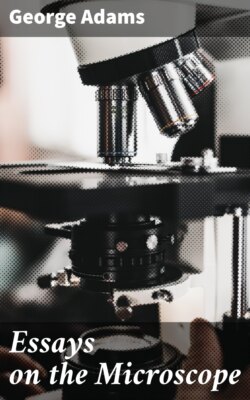Читать книгу Essays on the Microscope - George Comp Adams - Страница 56
На сайте Литреса книга снята с продажи.
THE POCKET BOTANICAL AND UNIVERSAL MICROSCOPE.
ОглавлениеTable of Contents
This pocket instrument is represented at Plate VI. Fig. 2. It is by most naturalists deemed preferable to Dr. Withering’s, being equally simple, more extensive in its application, and the stage unincumbered; though that of M. Lyonet seems better adapted than either to the purposes of dissection only.
A B, a small arm, carrying three magnifiers, two fixed to the upper part, as at B, the other to the lower part of the arm, at C; these may be used separately or combined together, by which you have seven powers. The arm, A B, is supported by the square pillar I K, the lower end of which fits into the socket, E, of the foot, F G; the stage, D L, is made to slide up and down the square pillar. H, a mirror for reflecting light on the object.
To use this microscope, place the object on the stage, L, reflect the light on it from the mirror H, and regulate it to the focus, by moving the stage nearer to or further from the lenses at B C. The ivory sliders pass under the stage, L; other objects may be fixed in the nippers, M N, and then brought under the magnifiers; or they may be laid on one of the glasses fitted to the stage. The apparatus to this instrument consists of three ivory sliders, a pair of nippers, a pair of forceps, a flat glass, and a concave ditto, all fitted to the stage, L. By taking out the pin, M, the pillar, I K, may be turned half round, and the foot, F G, made to answer as an handle.[37]
[37] An adjusting screw, Fig. 13*, to move the stage, with other additions, are made by Messrs. Jones; and which then, in my opinion, constitute the most complete pocket microscope hitherto made; for the particulars of which, I refer the reader to their printed description. Fig. 14, represents the common flower or insect microscope. There are two lenses, a and b, that are used separately or conjointly. Edit.
